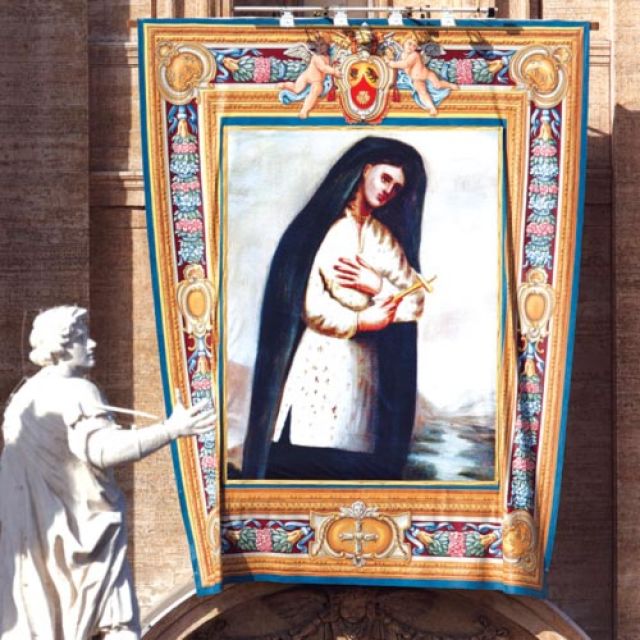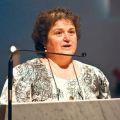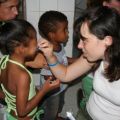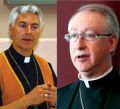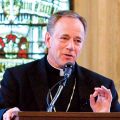NEWS
St. Kateri teaches us our response in faith to Jesus Christ brings healing, said Edmonton Archbishop Richard Smith at a Thanksgiving Mass in Rome Oct. 22.
“Among the most striking aspects of her witness is the miraculous transformation of her face soon after her death,” said the president of the Canadian Conference of Catholic Bishops (CCCB) in his homily at St. John Lateran, Rome’s cathedral church. “From the age of four, terribly scarred by the smallpox, her face was restored to its original beauty only minutes after she had died.”
Smith noted Kateri said “Jesus, I love you,” just before she died, showing how her response to Christ’s love preceded the healing.
“How greatly do we need this lesson from Kateri today,” he said. “We may not bear physical scars, but so many today carry deep emotional and psychological ones.
“These are inflicted not by smallpox but by poverty, addiction, loneliness and betrayal. They are caused by the abuse suffered by Kateri’s modern-day sisters and brothers in their time at residential schools,” he said. “So much pain, so many emotional scars. Yet Kateri teaches us that no wound, however deep, should leave us without hope.”
The archbishop called the facial healing “an outward sign of the interior transformation that is given to all who hand over their lives to Christ, and who do so in love.”
The Mass, televised live by Salt + Light Television, drew more than 2,500 people, many of them Canadian pilgrims. Almost 20 Canadian bishops were present, including concelebrants Bishop Lionel Gendron and Auxiliary Bishop Louis Dicaire of Saint Jean-Longueuil, who serve the diocese that includes the Mohawk territory where St. Kateri died. The all-party delegation led by Canada’s Speaker of the House of Commons, Andrew Scheer, attended as did Canada’s ambassador to the Holy See, Anne Leahy.
“The meeting of God’s loving initiative with a grace-filled human response is on beautiful display in the life of St. Kateri,” said Smith, who said her name Tekakwitha was one of the earliest signs.
Tekakwitha has a variety of interpretations: “she who feels her way ahead,” “moving forward slowly,” “one who bumps into things,” but also “one who places things in order” or “to put all into place,” the archbishop said.
“It is, of course, true that Kateri’s physical sight was seriously compromised due to the smallpox from which she suffered,” he said. “What is equally true, however, and what is of far greater significance, is that her inner vision was clear.
“Deep within her heart she had received the gift of seeing clearly the truth of Christ and His Church. It is as if God, through the very name Tekakwitha and the life of the one who bore it, has drawn attention to the limits of human vision in order to point us to the true sight that comes from faith.”
Smith tied the canonization of North America’s first female indigenous saint with the Year of Faith and the Synod on New Evangelization taking place in Rome until Oct. 28.
“Kateri reminds us that this new evangelization, to be effective, must not only be proposed anew but also find an open and ready welcome in the heart of the recipient,” he said. “When the Jesuit missionary, Fr. de Lamberville, spoke of our Lord and the Christian faith, the Gospel message of life and hope found a home within her.”
He called Kateri’s response to the Gospel message a “work of grace.”
“Only with the help of God’s grace are we able, like Kateri, to make of our entire lives a living and pleasing sacrifice to God, as St. Paul exhorts us to do,” he said. “Only with divine assistance do we become, like Kateri, the mothers, brothers and sisters of Christ by doing the will of His — and our — heavenly Father.”
An estimated 1,500 Canadian pilgrims attended the canonization in St. Peter’s Square, most of them from First Nations and other aboriginal communities. Among the 17 Canadian bishops was Toronto Cardinal Thomas Collins.
“Throughout her short life, St. Kateri never abandoned her faith,” said Prime Minister Stephen Harper in an Oct. 21 statement.
“The canonization of St. Kateri is a great honour and joyous occasion for the many North Americans and aboriginal peoples who cherish her witness of faith and strength of character. The Government of Canada stands with those who are celebrating her life on this day in Canada, the United States and throughout the world.”
The canonization Mass Pope Benedict XVI celebrated Oct. 21 is available via the cccb.ca web site or at www.saltandlighttv.org.
Jesus key to the new evangelization
By Evan Boudreau, The Catholic RegisterTORONTO - The challenge the Catholic Church faces with the new evangelization is to lead people out of the darkness, theologian and Catholic apologist Scott Hahn told a Toronto audience Oct. 20.
More than 1,400 people came to hear Hahn describe the new evangelization, its challenges and goals at Canada Christian College. He was brought to Canada by Catholic Chapter House for “The New Evangelization! Equipping Yourself To Engage The Culture.”
“Evangelization is the grace and vocation most proper to the Church,” said Hahn. “The new evangelization is new precisely because of the unique needs we now have. It’s re-evangelizing the secular cultures that are on the brink of losing any sense of their own Christian identity.”
A former Presbyterian minister, Hahn joined the Catholic Church in 1986. Since then he has penned 13 books, been awarded a doctorate in systematic theology from Marquette University and is president of St. Paul Centre for Biblical Theology, a Christian think thank in Steubenville, Ohio, which he founded in 2001.
In defining new evangelization, Hahn made note of four principle laws of evangelization: God loves you; you sin; Christ died for your sins; and what are you going to do? By acknowledging these fundamental aspects of Catholic evangelization, one is able to build the foundational personal relationship with Jesus.
“A personal relationship with Jesus is where we all have to begin but it’s only a beginning, it isn’t the end,” said Hahn.
That’s because the new evangelization goes far beyond developing a personal relation by reaching towards an understanding of the covenant of communion that reflects the inner life of God, the Son and the Holy Spirit.
The best way to develop, and promote, the connection to one’s faith is through attention to the real presence of Christ in the Eucharist. In other words, one must be able to see it as a holy sacrifice of Jesus’ body and blood rather than unleavened bread and a chalice of wine. Where people of the past would simply accept this because a priest said it was so, today society demands an understanding of it and that is the goal of new evangelization. Our greatest tool to find this understanding, said Hahn, is the Catechism of the Catholic Church.
“It isn’t something that is just over and done in a day,” he said. “It’s something that you can start anywhere you find yourself but it is always going to lead to the goal of eucharistic communion.”
But new evangelization faces resistance even from those already deeply connected to their Catholic faith. Hahn summarized the common objections to undertaking the task into two categories: Catholics don’t evangelize and it’s not about telling, it’s about action. To both Hahn has one response.
“To be a Catholic is a call to bear witness to our faith no matter where we find ourselves in life. To not share is to not be Catholic.”
Family services to kickstart conversation on ‘terrible evil’
By Michael Swan, The Catholic RegisterCardinal Thomas Collins will meet and pray with faith leaders from across Toronto to start a more public conversation about violence against women in the spring of 2013.
Catholic Family Services is organizing the interfaith service, which Collins committed to attending in a message to the third annual Mass to End Woman Abuse celebrated at Blessed Trinity Church in Toronto Oct. 16.
Collins called violence against women a “terrible evil.”
“Often this happens out of the sight of the world, but those who experience it experience enormous grief and pain,” Collins wrote.
The idea that faith leaders are ready to publicly talk and pray about how women suffer at the hands of men is “a very good thing,” said Canadian Women’s Foundation president and CEO Bev Wybrow.
“What we would like to see come out of it is looking at the most effective ways to address violence in the context of faith communities,” Wybrow said. “That is very, very important to some women in particular and it hasn’t always been as appropriate as it should be.”
This year’s Mass to End Woman Abuse, organized by Catholic Family Service of Toronto, attracted about 200.
“I would want it to be standing room only,” said Kelly Bourke, who directs the Faith Connections youth program for the Sisters of St. Joseph of Toronto. “I find it challenging that it’s not.”
Though the Church may not be full, the annual event is giving a higher profile to the issue, said Virginia Koehler, director of Catholic Family Services woman abuse programs. With each Mass Catholic Family Services has seen an increase in referrals and volunteers.
“Priests are calling — priests we haven’t heard from,” she said.
The Mass particularly concentrates on thanking and honouring survivors of spousal abuse who volunteer as mentors in Catholic Family Services’ Women Helping Women program.
The impulse to keep silent about violence within marriages is exactly the cover abusers need, said Lucia Furgiuele, Catholic Family Services of Toronto executive director.
“We stand united in breaking the silence that accompanies this issue,” she said.
Women should never be told to be obedient and pray in the face of violence, said Furgiuele.
“Our Church teaches that women should leave abusive situations that persist,” she said.
Prayer is not irrelevant, said Wybrow.
“Prayer can be accompanied by concrete action as well and help make sure action is appropriate as possible,” she said.
Catholic justice program under attack at Brock
By Michael Swan, The Catholic RegisterA woman’s studies professor at Brock University in St. Catharines, Ont., is within her rights to criticize and badger volunteers who work at a Catholic-inspired social justice program on campus, the Ontario Human Rights Tribunal has ruled.
The decision was the latest episode in a five-year war of words between the university’s women’s studies program and Solidarity Experiences Abroad, a program that places students from the school in volunteer jobs in Latin America and is administered by the university’s Roman Catholic chaplaincy.
Women’s studies and sociology professor Ana Isla alleges that the SEA program has ties to “far right” and “cult-like” Catholic organizations in Peru. She claimed in a motion passed by the women’s studies program committee in 2011 that “there have been documented cases of physical and psychological abuse, classism, sexism, racism and homophobia in activities related to Solidarity Experiences Abroad.”
German McKenzie, who ran the SEA program at Brock for eight months in 2010 and continues to volunteer with the chaplaincy office, complained of Isla’s rhetoric to the Human Rights Tribunal in January. In his Oct. 9 decision, Ken Bhattacharjee said the tribunal should not intervene in the internal affairs of the university where issues of academic freedom are at stake.
“In my view, given the importance of academic freedom and freedom of expression in a university setting, it will be rare for this tribunal to intervene where there are allegations of discrimination in relation to what another person has said during a public debate on social, political and/or religious issues in a university,” Bhattacharjee wrote.
McKenzie claims he wasn’t trying to limit anyone’s academic freedom, only protect his reputation.
“I respect academic freedom, but academic freedom has to be exercised responsibly,” McKenzie told The Catholic Register. “How do you balance that in a university? That’s a big thing. I’m not saying it’s easy.”
He had asked the tribunal to suspend the case while the university’s own human rights committee looks into the case. But once started, the tribunal decided to render its decision.
“From my side, it makes sense for everybody to solve this grievance at the lower level than at the higher,” said McKenzie. “That’s what common sense tells me.”
Brock University chaplain Raoul Masseur expects the university’s human rights committee to issue a report very soon. University administration refused to comment on the committee report.
McKenzie is a doctoral candidate at Catholic University of America who expects to graduate with a PhD in secularization theory in the coming months. He hopes to launch an academic career in Canada and felt Isla’s campaign against SEA and himself were poisoning his chances.
Brock administration has already once ruled that Isla’s accusations are unfounded and that the relationship between the university and SEA has been beneficial to the university. The university’s “internationalization committee” investigated Isla’s allegations against SEA in January and found “there was no compelling evidence to support such an action (severing ties with SEA) and further affirms its support for this partnership.”
The committee, headed by university provost Murray Knutila, said that consenting adults should be trusted to make an informed choice about whether or not to participate with SEA, so long as the program was clear about its affiliations. While inspired by Catholic social teaching, the program is a non-denominational invitation to the whole Brock community, said Masseur, the SEA founder.
Isla’s campaign against SEA was bolstered last year by the CUPE-financed Occupy Brock movement on campus.
“We ask to take a stand and only officially sanction volunteer opportunities with non-religious organizations,” associate dean of social sciences June Corman told an Occupy Brock rally Sept. 17, 2011. “And that in fact, all course work opportunities at Brock also not be involved with specific religious organizations.”
SEA has more than 360 Brock students, faculty and alumni preregistered for solidarity trips in this academic year. As the movement to cut ties to SEA gained ground last winter it took Masseur less than a week to gather 200 letters of support from more than 1,200 past participants in SEA trips.
E-mails and phone calls to Isla for this article were unanswered.
Edmonton twins with northern diocese
By Ramon Gonzalez, Canadian Catholic NewsEDMONTON - The Edmonton archdiocese and the diocese of Mackenzie-Fort Smith have entered into a twinning arrangement that may lead to more co-operation between the two dioceses.
Edmonton has sent a priest to Mackenzie-Fort Smith and will give half the proceeds from its Nov. 21 Jubilee Gala to this northern diocese to help pay for a new church.
“This is sort of a partnership of mutual support and mutual enrichment,” said Archbishop Richard Smith, who will visit Mackenzie-Fort Smith in March.
In an Oct. 15 interview, the archbishop said this type of twinning arrangement goes back to the 1990s when Blessed John Paul II in his apostolic letter Ecclesia in America encouraged the dioceses of the Western Hemisphere to consider ways that they may enter partnerships with one another of mutual support.
As the question arose about a partnership between Edmonton and another diocese, Smith said his thoughts naturally turned towards South America.
“But as we talked internally about this more and more the question came up what about the needs of our people in the North of Canada?” he said.
The idea of Edmonton, the gateway to the North, twinning with Mackenzie-Fort Smith resonated with local Catholics, he said. Smith said the twinning also recognizes that the Edmonton archdiocese was established through the efforts of missionaries.
“We are the result of a missionary effort and that’s a reminder to us that the Church is and must always be missionary in its outreach.”
Mackenzie-Fort Smith Bishop Murray Chatlain said he is pleased with the twinning. Apart from the sharing of human and material resources, it “will give people (in the Edmonton archdiocese) a chance to understand more who we are, what our life is like and what are some of our blessings and challenges.”
The wheels of the twinning agreement are already in motion. Last June, youth leader Andrew Papenbrock visited Mackenzie-Fort Smith to lead a workshop on youth ministry. Since then, Papenbrock has helped the northern diocese with other youth ministry issues, Chatlain said.
As well, Fr. Arlan Parenteau, an Edmonton priest, was recently sent to serve the northern diocese. “Obviously this is a sacrifice on our part because we certainly need every priest that we can have, but at the same time we have to recognize that the Lord calls us to be generous,” Smith said. Smith said the two dioceses will ask what gifts they can share. When Chatlain spoke in Edmonton at the archdiocese’s Nothing More Beautiful event, Smith recalled, he talked about the great importance that is placed in the North on silence in the encounter with the other.
“That’s something our busy Western culture needs to learn — the value of silence and, within silence, encountering the reality of the other and encountering the reality of God in our midst.”
Chatlain said many people in his diocese travel to Edmonton, especially when facing serious medical issues, and end up attending the city’s parishes. The partnership may enable a deepening of those relationships, he said.
Chatlain said Mackenzie-Fort Smith and Edmonton are also encouraging the twinning of parishes from the dioceses. Funds from the Jubilee Gala, which he will attend, might be used to help renovate the church in Tuktoyaktuk and build a new church in Fort Simpson.
The Mackenzie diocese has 11 priests to cover about 38 communities.
“If we have 10 or 11 healthy priests, I think for the size we are it’s okay,” he said.
“What we are trying to do is to encourage the local leadership.”
Lay people, Chatlain said, lead services, funerals, Baptisms and even perform marriages.
(Western Catholic Reporter)
MP Vellacott lauded, and vilified, for awarding medals to pro-life activists
By Deborah Gyapong, Canadian Catholic NewsOTTAWA - A Conservative MP who came under fire for awarding Diamond Jubilee Medals to pro-life activists who have served time in prison has garnered plenty of support from those who see the activists as prisoners of conscience.
Anti-poverty caucus seeks non-partisan solutions
By Deborah Gyapong, Canadian Catholic NewsOTTAWA - Ottawa’s All-Party Anti-Poverty Caucus continues to search for nonpartisan solutions to poverty — but it won’t be easy.
The caucus marked International Day for the Eradication of Poverty Oct. 17 with a panel discussion entitled “Ending Poverty Together: Real Stories, Real Solutions.” It brought together NDP, Liberal and Conservative MPs and Senators, representatives from anti-poverty groups, and two panelists who shared their lived experience of poverty.
“We’re good at raising awareness,” said NDP human resources critic Chris Charlton, caucus co-chair. “We’re not so good at moving the yard sticks.
“Government programs can make a difference if we design them right.”
Though Charlton would like to see greater tax fairness, she acknowledged higher taxes were not likely to find all-party support. She praised a Tory program, however, that helps the working poor rise out of poverty as one example of a program all parties support.
Caucus co-chair Liberal Senator Art Eggleton decried the fact one in 10 Canadians live in poverty and one out of four are children. Poverty costs Canada about $30 billion, according to a recent study, he said, with health care costs alone consuming about $7.5 billion.
“The social welfare system treats the symptoms, but leaves the disease untouched,” he said.
It is less expensive to give someone a home and support services than to leave him or her on the street, he said, because street people drive up hospital costs through use of emergency rooms.
They can also end up costing the justice system money.
“We know the facts; we know the answers,” said Eggleton, the former Toronto mayor and Liberal cabinet minister.
“Why isn’t something happening?”
It is a matter of political will, he said, noting the caucus is trying to build it.
Eggleton also raised concerns about growing income inequality that is affecting not only the poor but also the middle class, calling the gap a threat to Canada’s social cohesion.
Conservative Senator Don Meredith, who is caucus treasurer, said he grew up poor in Jamaica, arriving in Canada at the age of 12. He lived with his family in social housing in the tough Jane-Finch area of Toronto. He credited his family, religious faith and hard work in “overcoming adversity and finding success.”
“This is not about partisan lines,” he said. “It is about the lives of Canadians.”
He stressed entrepreneurship, job creation and reaching at-risk youth.
Geraldine King, a young First Nations woman, said intergenerational poverty had become normalized to the extent she did not realize she was poor until peers started making fun of her when she reached age seven or eight. She thought going to food banks and wearing second hand clothes from a bin was something everyone did.
King credited a federal program with helping her get out of poverty. A new employment insurance (EI) rule allowed her to resign from her lower paying job to seek more training by attending university while still receiving EI benefits. This program helped her survive her first year in university. After that she qualified for bursaries and scholarships.
King said she was lucky to find out about the program because systemic barriers keep people like herself from finding out about them, especially those without computer access or living in First Nations communities.
Linda LeBlanc, an anti-poverty advocate who raised two children on and off social assistance, depending on her health or employment status, spoke of the isolation and marginalization she experienced.
Many poor people cannot leave their homes for lack of money and transportation, disability issues or pregnancy or small children, she said. Being poor means constantly juggling, never knowing what is going to come at you, just struggling to get through the day.
Though many say the best social program is a job, without supports like housing, child care and transportation the job will not do much good, she said.
Then there are many who can’t take a job even if the supports are in place.
LeBlanc said the best consultants on poverty are those who have lived it, but they often cannot find the money to attend meetings like this.
As long as there has been a Cobourg, St. Michael’s has looked after its Catholic population
By Evan Boudreau, The Catholic RegisterFor as long as Cobourg, Ont., has existed, St. Michael’s parish has been there for its citizens.
St. Michael’s parishioners were to celebrate the 175th anniversary of the town’s original Roman Catholic parish with an anniversary celebration on Oct. 27.
“We just want to celebrate the wonderful gift of a parish, a Catholic parish, that’s 175 years (old),” said Fr. Andrew Ayala, St. Michael’s pastor.
Ayala was to kick off the day of celebration with a 5 p.m. Mass, with a sold-out dinner to follow at Cobourg’s historical Victoria Hall.
The parish hasn’t always gone by the name St. Michael’s. When it was established in 1837 by Fr. A. Kernan, the parish took the name of St. Polycarp. The original church building opened on William Street, about three km from the current location at 379 Division St., two years later. When the doors opened, the small wooden church served a congregation of 50 souls.
By 1859 the capacity of the 1,029-square-metre church was deemed inadequate by the parish’s third pastor, Fr. Michael Timin, who served for 33 years at St. Michael’s. So construction began on a brick addition to double the building’s size.
Four years later a fire destroyed the original wooden structure. Restored in brick to match the addition, Bishop Patrick Phelan rededicated the parish to St. Michael, who remains the namesake to this day.
On June 9, 1895 the cornerstone of the current church was laid. The new building was finished in less than one year.
The spirit that helped establish the parish and keep it going for 175 years can be seen in today’s parishioners, said Ayala, and in the planning for the milestone celebration in particular. Planning for the anniversary celebration began in August. This is where parishioners really stepped up to the plate to make the celebration come to fruition.
“God is giving this parish a great gift in the people it has,” said Ayala. “If I have to say something about this parish it’s that the lay people take very seriously their mission in the parish.”
The entire event, organized in less than two months, is a testament to the large impact a small community can have when they come together, said Ayala.
“At the end of August I shared this idea first with my secretary and my secretary told me about one person in the parish, the former mayor of the town, who would be able to organize that,” said Ayala.
That person was Peter Delanty who Ayala asked to establish an organization committee. Before the pastor knew it Delanty gathered seven others to work on the celebrations.
“In math one plus one is two but in my mission we say one plus one equals 2,000 because we can do much more when we come together,” said Ayala.
This was a great help to Ayala. A native of Argentina, English is his second language. And as pastor of a parish that sees about 900 visitors between the three Sunday services alone, Ayala’s time is limited. When the four high schools, hospital, youth correctional centre, five retirement homes and countless house calls, which absorb much of his non-preaching time, were factored in Ayala needed the help.
By early September the committee began holding meetings and relaying their plans to Ayala for approval.
“A wonderful committee of parishioners were able to organize it so well, I’m very happy with that,” he said. “There’s so much spiritual work to do I would have never been able to organize it if it wasn’t for the lay people,”
Along with dinner, those in attendance will also be entertained by the local jazz band from St. Mary’s Catholic Secondary School, receive a history lesson from Delanty and hear from Peterborough’s Bishop Nicola De Angelis.
Unattached individuals face growing poverty rates, says study
By Deborah Gyapong, Canadian Catholic NewsOTTAWA - Individuals living alone without family ties form a new growing risk-group for poverty, says a new study by Citizens for Public Justice (CPJ) released Oct. 17.
At a news conference, CPJ executive director Joe Gunn blamed the rise of “precarious employment” for the growing risk to unattached working individuals of falling into poverty. Don’t believe the line that simply getting a job will get one out of poverty, he said.
“It has to be a good job,” he said.
“Working-age individuals living on their own are now much more likely to be poor than individuals living in family situations,” says CPJ’s Poverty Trends Scorecard—Canada 2012, released to mark the International Day for the Eradication of Poverty.
The study shows poverty among households with two or more workers accounted for a “shocking” 12 per cent of Canada’s poor. Households with one worker make up 39.1 per cent of Canada’s poor.
“Inadequate income support programs for working-age individuals and families ensure a life of poverty for almost one million Canadians,” the study says.
The study also identifies young adults as “more likely to be poor today than they were three decades ago,” noting fewer young people are working in 2012 than at the peak of the 2008-2009 recession.
Other groups that face higher risk of poverty and the likelihood of long-term poverty are aboriginal peoples, recent immigrants, the disabled and “racialized communities,” the study says.
The study shows the higher poverty levels caused by the recent recession were largely overcome by 2010, though Alberta and British Columbia have not fully recovered.
Not all the news is bad, Gunn pointed out. The study shows that over the past 15 years, Canada has seen a decline in overall poverty rates, “especially among children and seniors.” Gunn said this result shows government support programs can work to reduce poverty.
CPJ reported progress in reducing poverty in Newfoundland and Labrador, Prince Edward Island, Saskatchewan and Quebec.
“Poverty among lone-parent families has fallen as women’s position in the labour market has improved, and their average duration of poverty has decreased,” the study says.
Supports for working age and unattached people have “weakened” since the 1990s, the study says.
“Lack of support is a critical issue with the loss of middle-income jobs in Canada.”
Gunn said the House of Commons has pledged twice to overcome poverty and the House HUMA committee developed a plan that still needs to be implemented. That it has not been shows “a failure of our commitment to show we are here for the common good of all.”
Former papal butler begins 18-month sentence in Vatican prison cell
By Carol Glatz, Catholic News ServiceVATICAN CITY - Paolo Gabriele, the pope's former butler who was found guilty of aggravated theft, was to be transferred from house arrest to a Vatican prison cell to begin his 18-month sentence.
Because the Vatican's prosecutor decided not to file an appeal, Gabriele would immediately begin serving his prison sentence by order of a Vatican court, said Jesuit Father Federico Lombardi, Vatican spokesman.
"The order will be carried out before the end of the day," he said Oct. 25.
Gabriele, who worked at Pope Benedict XVI's side as his assistant since 2006, will not be allowed to seek any employment at the Vatican in the future, the spokesman said.
Gabriele's violation of the trust of the pope and the privacy of so many people underlines his "incompatibility" with employment at the Vatican, he added.
While the Vatican has begun the necessary paperwork for terminating Gabriele's employment, the Vatican will proceed "with humanity and attention," Father Lombardi told Catholic News Service, saying it will take into consideration the fact that the 46-year-old Italian was supporting a family with three children in an apartment on Vatican property.
He will be detained in one of the recently refurbished prison cells inside the Vatican police barracks.
In a communique issued the same day, Cardinal Tarcisio Bertone, Vatican secretary of state, said Gabriele's crime caused great damage to the pope and to the universal church.
By stealing private correspondence to and from the pope, and other sensitive documents, and by leaking them to an Italian journalist, Gabriele committed "a personal offence against the Holy Father," the cardinal wrote.
His actions also "violated the right to privacy of many people; created prejudice against the Holy See and its different institutions; created an obstacle between the communications of the world's bishops and the Holy See; and caused scandal to the community of the faithful," he wrote.
The affair also "disrupted the serenity" of those who work at the Vatican, he added.
After a Vatican-led investigation, which started in May, and four days of courtroom proceedings attended by a pool of Vatican journalists, Gabriele was found guilty of aggravated theft and sentenced Oct. 6.
Cardinal Bertone said the whole process was carried out with "transparency, equanimity, and in full respect of the rights" of the accused.
The results of the investigation and trial also showed that Gabriele had spearheaded "his criminal project without instigation or prompting by others, but rather based on personal convictions that were in no way held by others," he wrote.
Therefore, the numerous "speculations about some plot or involvement" of other people is "unfounded," the cardinal said.
The secretary of state said it is still possible that Pope Benedict will pardon Gabriele, but such a move "rightly presupposes the reform of the offender and a sincere request for pardon from the Holy Father and all who were unjustly hurt" by his actions.
Gabriele's lawyer had told an Italian newspaper in July that Gabriele had written "a confidential letter to the pope," asking for his forgiveness and telling the pope he had acted alone.
Gabriele had told investigators that he had acted out of concern for the pope, who he believed was not being fully informed about the corruption and careerism in the Vatican.
Vancouver program aims to bring Catholics home
By Nathan Rumohr, Canadian Catholic NewsVANCOUVER - The archdiocese of Vancouver is inviting Catholics to come back to their faith this holiday season with a “Catholics Come Home” (CCH) initiative, Archbishop J. Michael Miller announced during his fundraising dinner Oct. 25.
CCH is a multi-faceted campaign that combines media and parish outreach to bring fallen-away Catholics back to the Church. The media component involves commercials produced that will air between Dec. 13 and Jan. 20 on major TV stations in Vancouver. Parishes have been preparing outreach plans to welcome those inspired by the commercials.
“In the archdiocese of Vancouver there may be as many as 250,000 Catholics who need us to reach out and welcome them,” said Miller. “Every one of us has family members, friends or co-workers who once were active Catholics and now are no longer.”
“With the upcoming Catholics Come Home initiative we have a wonderful opportunity to reach out to others and be spiritually renewed in the process,” said Kyle Neilson, director of the office of evangelization for the archdiocese and part of the CCH Vancouver team.
Hundreds of parish representatives gathered at St. Patrick’s, Our Lady of Fatima and St. Matthew’s parishes Sept. 28 to 30 to hear Ryan Hanning, director of parish leadership for the diocese of Phoenix, discuss some of the ideas on how to welcome Catholics back. Hanning’s diocese was the pilot for Catholics Come Home in 2008. The diocese helped produce commercials which later ran in several U.S. dioceses and in other countries.
“When we ran the campaign we didn’t know what to expect and didn’t know who our audience was,” Hanning said.
He shared some of the CCH findings and described the state of Catholicism in Vancouver, saying the west coast city is second only to Berlin as the most secular city in the world.
“Thirty-six per cent of people that live in Vancouver say they are atheist or agnostic,” Hanning reported. “There is a huge mission field here.”
He said there are more than 450,000 registered Catholics in the archdiocese, 17 per cent of the population. Of those, 22.5 per cent attend Mass every week, 12 per cent attend Mass monthly and 42 per cent attend Mass occasionally.
Hanning also talked about the “inactive Catholics” that make up 25 per cent of the Catholic population. He went over some reasons why those Catholics are inactive.
“When we prepared for the campaign we expected the vast majority of those who had left the faith did so because they were angry or mad,” Hanning said. “The opposite was true.”
He said reasons such as the sex-abuse scandal were not actually as statistically high as many had predicted. He said of the 6,000 people who contacted them in the Phoenix diocese, only a few claimed the reason they left the Church was the sex-abuse scandal.
Most people he encountered left for social reasons.
“They live in a society that doesn’t always respect the role of, and the importance of, religion in life.”
Hanning said the challenge for parishes will be to find their own unique way of welcoming returning Catholics.
“I’ve been in parish life and know the challenges,” Hanning said. “I know there is a temptation to respond (to the campaign) with a program; a one size fits all. People don’t want to come back to a program; they want to come back to a person: Christ.”

